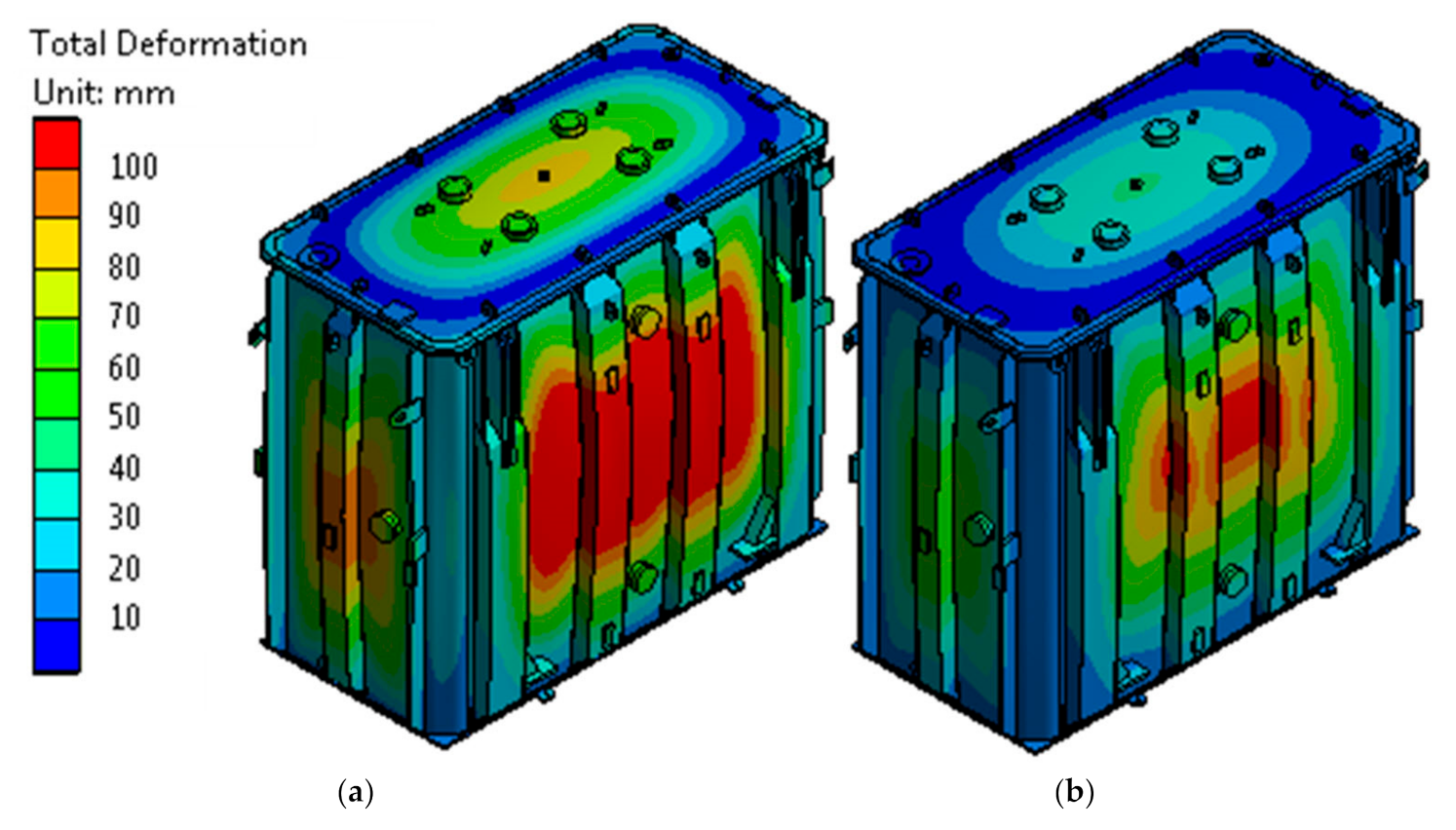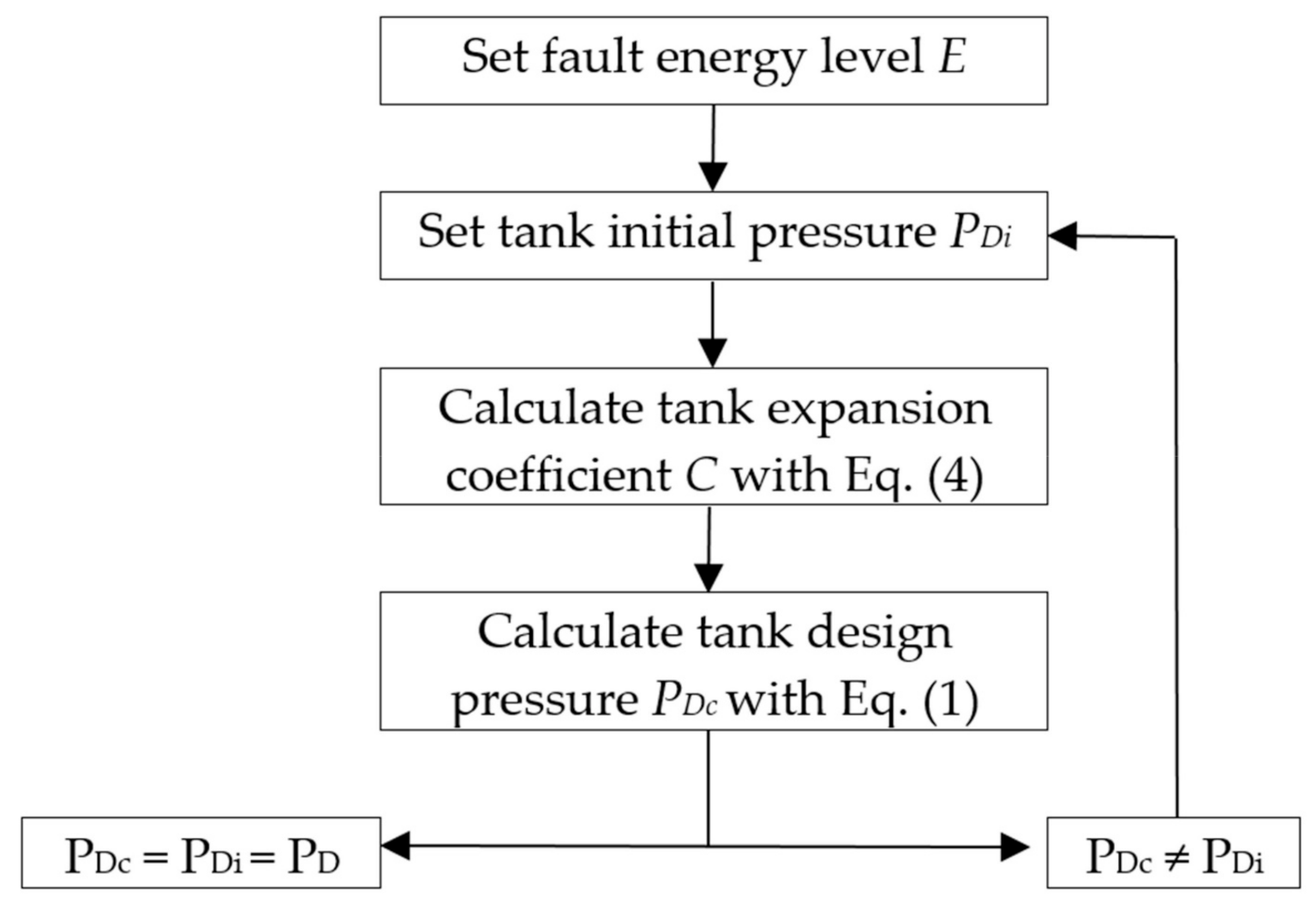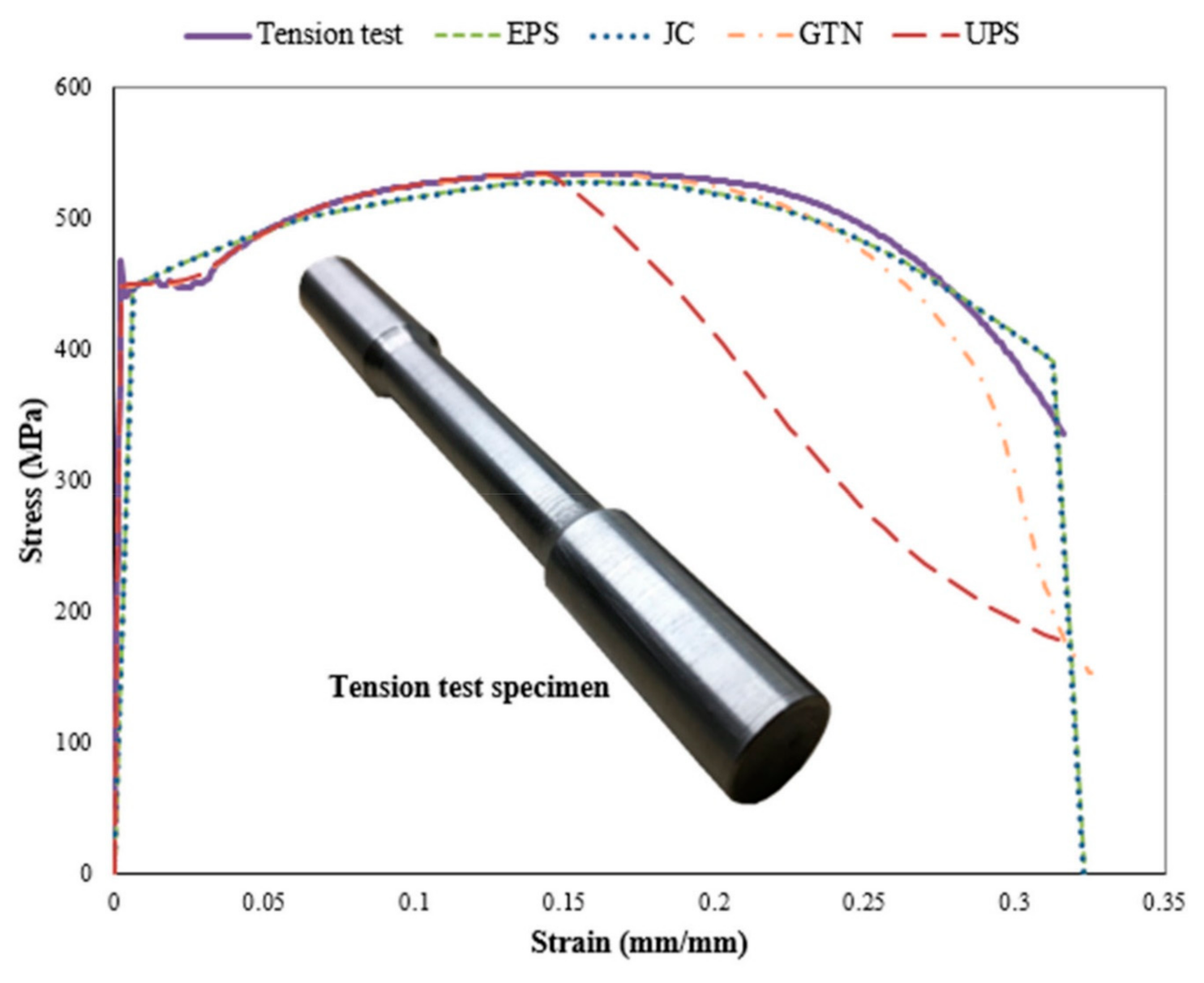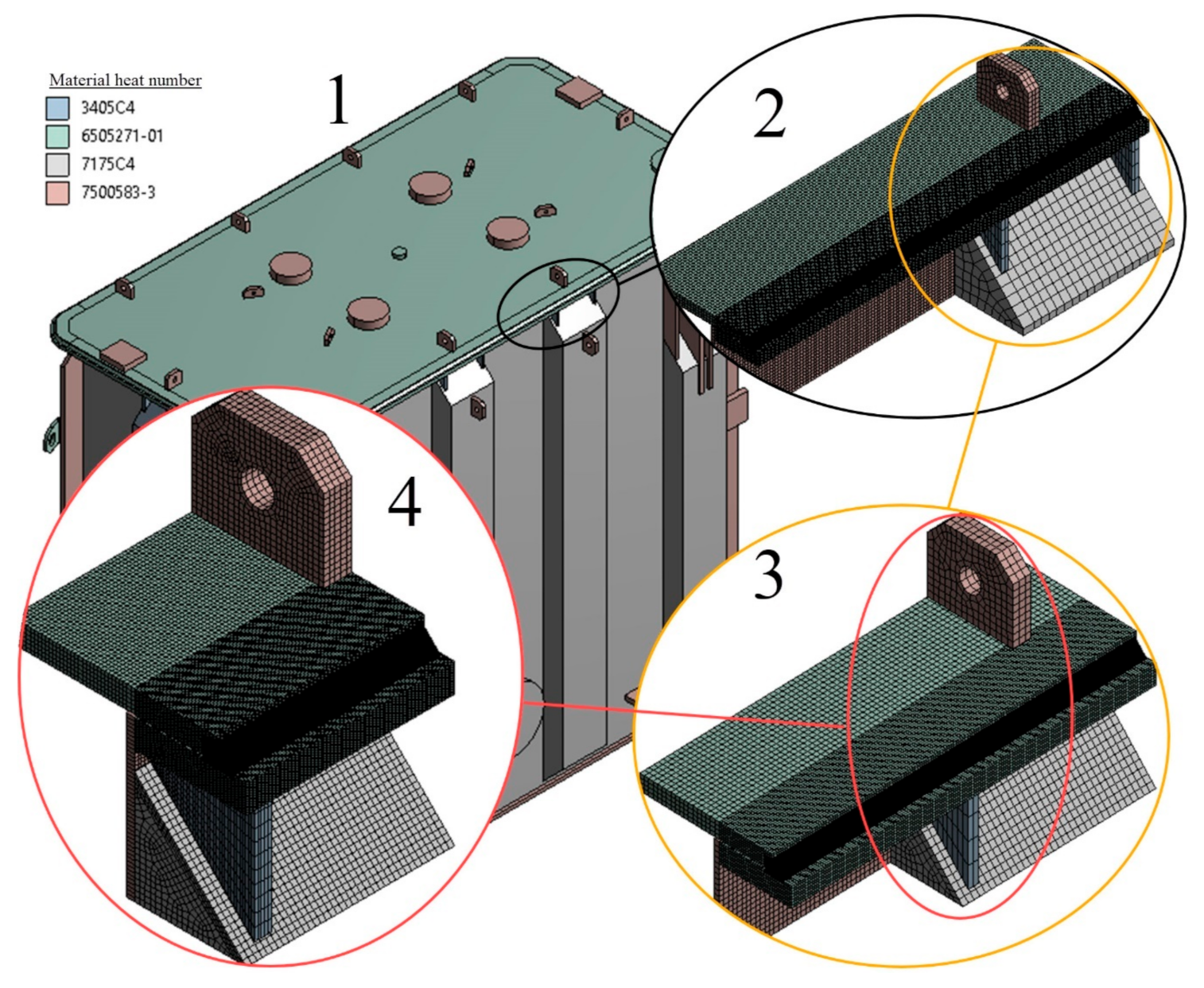A Nonlinear Finite-Element Analysis Tool to Prevent Rupture of Power Transformer Tank
Abstract
1. Introduction
2. Tank Pressure Rise
- PD
- Tank design pressure (kPa);
- E
- Fault energy level (kJ);
- k
- Arc energy conversion factor (5.8 × 10−4 m3/kJ) (@ 2000 K);
- C
- Tank expansion coefficient (m3/kPa);
- F
- Dynamic amplification factor;
- PH
- Hydrostatic pressure (kPa).
- Nonlinear material properties.
- Ability to increase tank volume as a function of pressure.
- Ability to obtain a tank expansion coefficient by an iterative process.
2.1. Nonlinear Material Properties
- Engineering curve: tension test engineering stress–strain curve for regions I to IV.
- True curve (Equation (2)): tension test true stress–strain curve calculated using Equation (2) up to region IV.
- True curve (Equation (3)): tension test true stress–strain curve calculated using Equation (2) for region IV and Equation (3) for region V.
2.2. Tank Volume Increase in Function of the Pressure
2.3. Calculation of the Tank Expansion Coefficient
3. Tank Rupture
3.1. Equivalent Plastic Strain (EPS) Criterion
3.2. Johnson–Cook (J–C) Criterion
- σe Equivalent stress (kPa);
- Stress triaxiality.
3.3. Gurson–Tvergaard–Needleman (GTN) Criterion
3.4. Ultimate Plastic Strain (UPS) Criterion
4. Advantages of Tank Rupture Prevention Using Numerical Simulation
5. Conclusions
Author Contributions
Funding
Conflicts of Interest
References
- Working Group A2.33. Guide for Transformer Fire Safety Practices; CIGRÉ Technical Brochure 537; CIGRÉ: Paris, France, 2013. [Google Scholar]
- Foata, M. Power Transformer Fire Risk Assessment. In Proceedings of the CIGRÉ Transformer Technology Conference, Sydney, Australia, 31 March 2008. [Google Scholar]
- Brodeur, S.; Dinh, H. A Station Service Voltage Transformer Designed and Tested to Withstand a Severe Internal Arc Fault. In Proceedings of the CIGRÉ Transformer Technology Conference, Montréal, QC, Canada, 16–19 September 2019. [Google Scholar]
- Foata, M.; Khouzam, G. Power Transformer Tank Rupture; Canadian Electrical Association, Engineering and Operating Division: Toronto, ON, Canada, 1994. [Google Scholar]
- Kothmann, R.E.; Thompson, D.G. Power Transformer Tank Rupture: Risk Assessment and Mitigation; EPRI, Technical Report TR-104994; EPRI: Washington, DC, USA, 1995. [Google Scholar]
- Brodeur, S.; Dastous, J.-B. Design and Testing of an Arc Resistant Power Transformer Tank. IEEE Trans. Power Deliv. 2020, 35, 699–706. [Google Scholar] [CrossRef]
- Cuk, N.P. Oil Tank Explosion Resistance; CEA 149D491; Canadian Electricity Association: Surrey, BC, Canada, 1990. [Google Scholar]
- Dastous, J.-B.; Foata, M. Analysis of Faults in Distribution Transformers with MSC/PISCES-2DELK. In Proceedings of the MSC World Users Conference, Los Angeles, CA, USA, 11–15 March 1991. [Google Scholar]
- Kawamura, T.; Ueda, M.; Ando, K.; Maeda, T.; Abiru, Y.; Watanabe, M.; Moritsu, K. Prevention of Tank Rupture Due to Internal Fault of Oil-Filled Transformer; CIGRÉ: Paris, France, 1988. [Google Scholar]
- Foata, M.; Dastous, J.-B. Power Transformer Tank Rupture Prevention. In Proceedings of the CIGRÉ Transformer Technology Conference, Paris, France, 22–27 August 2010. [Google Scholar]
- Baïlon, J.-P.; Dorlot, J.-M. Des Matériaux, 3rd ed.; Presses Internationales Polytechnique: Montréal, QC, Canada, 2000; p. 768. [Google Scholar]
- Arasaratnam, P.; Sivakumaran, K.S.; Tait, M.J. True Stress-True Strain Models for Structural Steel Elements. ISRN Civ. Eng. 2011, 2011, 11. [Google Scholar] [CrossRef]
- Khan, A.S.; Huang, S. Continuum Theory of Plasticity, 1st ed.; John Wiley & Sons Inc.: New York, NY, USA, 1995; p. 440. [Google Scholar]
- Lee, H.-H. Finite Element Simulations with ANSYS Workbench 12, 1st ed.; Schroff Development Corporation: Kansas City, MO, USA, 2010; p. 586. [Google Scholar]
- Hackl, A.; Hamberger, P. Predict the rupture of transformer tanks with static FEM analysis. In Proceedings of the IEEE XXth International Conference on Electrical Machines, Marseille, France, 2–5 September 2012. [Google Scholar]
- Ringlee, R.J.; Roberts, N.W. Tank Pressures Resulting from Internal Explosions. AIEE Trans. 1959, 78, 1705–1710. [Google Scholar] [CrossRef]
- IEEE. IEEE Guide for Tank Rupture Mitigation of Liquid-Immersed Power Transformers and Reactors; IEEE Standard C57.156-2006; IEEE: Piscataway, NJ, USA, 2016. [Google Scholar]
- Tamez, G.; Payan, L.; Amador, L. A more accurate numerical method to calculate pressure rise due to internal electrical faults in oil-filled power transformer tanks. In Proceedings of the IEEE PESGM Conference, Portland, OR, USA, 5–9 August 2018. [Google Scholar]
- Bélanger, S.; Brodeur, S.; Dastous, J.B.; Soucy, N. Experimental and Numerical Studies of Large Steel Plates Subjected to High Pressure Loading. In Proceedings of the World Congress on Computational Mechanics Session, Barcelona, Spain, 20–25 July 2014. [Google Scholar]
- Corona, E.; Reedlunn, B. A Review of Macroscopic Ductile Failure Criteria; Sandia National Laboratories: Albuquerque, NM, USA, 2013. [Google Scholar]
- Kossakowski, P.G. An analysis of the Tvergaard parameters at low initial stress triaxiality for S235JR steel. Pol. Marit. Res. 2014, 21, 100–107. [Google Scholar] [CrossRef]











| Material | Large Deflection | Hardening Rule | Tank Max. Disp. (mm) | Tank Volume (m3) |
|---|---|---|---|---|
| Test reported in [6] | 108 | 2.2 | ||
| FEA linear | No | No | 5 | 0 |
| FEA engineering curve | Yes | Isotropic | 109 | 2.07 |
| FEA true curve (Equation (2)) | Yes | Isotropic | 108 | 2.05 |
| FEA true curve (Equation (3)) | Yes | Isotropic | 110 | 2.11 |
| FEA true curve (Equation (3)) | Yes | Kinematic | 109 | 2.10 |
| FEA true curve (Equation (3)) | No | Isotropic | Not converging | |
| Material | fo | fc | q1 | q2 | q3 | εN | fN | SN |
|---|---|---|---|---|---|---|---|---|
| S235JR [21] | 0.001 | 0.06 | 1.5 | 1 | 2.25 | 0.3 | 0.04 | 0.05 |
| Weld | 0.001 | 0.06 | 1 | 1 | 2.25 | 0.3 | 0.04 | 0.05 |
| Model | Mesh Size (mm) | Number of Nodes | Calculation Time | fF | Tank Pressure at Rupture (kPa) |
|---|---|---|---|---|---|
| 1. Global | 40 | 193 k | 3 h 38 m | - | - |
| 2. Submodel | 2 | 975 k | 37 h 46 m | 0.108 | 1420 |
| 3. Submodel | 1 | 1919 k | 135 h 5 m | 0.187 | 930 |
| 4. Submodel | 0.5 | 5298 k | 348 h 4 m | 0.342 | 920 |
| Model | Mesh Size (mm) | Number of Nodes | Calculation Time | Tank Pressure at Rupture (kPa) |
|---|---|---|---|---|
| 1. Global | 40 | 193 k | 3 h 38 m | - |
| 2. Submodel | 2 | 975 k | 8 h 15 m | 900 |
| 3. Submodel | 1 | 1919 k | 69 h 52 m | 790 |
| 4. Submodel | 0.5 | 5298 k | 130 h 11 m | 730 |
Publisher’s Note: MDPI stays neutral with regard to jurisdictional claims in published maps and institutional affiliations. |
© 2021 by the authors. Licensee MDPI, Basel, Switzerland. This article is an open access article distributed under the terms and conditions of the Creative Commons Attribution (CC BY) license (http://creativecommons.org/licenses/by/4.0/).
Share and Cite
Brodeur, S.; Lê, V.N.; Champliaud, H. A Nonlinear Finite-Element Analysis Tool to Prevent Rupture of Power Transformer Tank. Sustainability 2021, 13, 1048. https://doi.org/10.3390/su13031048
Brodeur S, Lê VN, Champliaud H. A Nonlinear Finite-Element Analysis Tool to Prevent Rupture of Power Transformer Tank. Sustainability. 2021; 13(3):1048. https://doi.org/10.3390/su13031048
Chicago/Turabian StyleBrodeur, Samuel, Van Ngan Lê, and Henri Champliaud. 2021. "A Nonlinear Finite-Element Analysis Tool to Prevent Rupture of Power Transformer Tank" Sustainability 13, no. 3: 1048. https://doi.org/10.3390/su13031048
APA StyleBrodeur, S., Lê, V. N., & Champliaud, H. (2021). A Nonlinear Finite-Element Analysis Tool to Prevent Rupture of Power Transformer Tank. Sustainability, 13(3), 1048. https://doi.org/10.3390/su13031048





